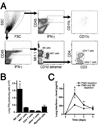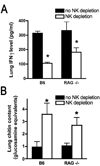Early NK cell-derived IFN-{gamma} is essential to host defense in neutropenic invasive aspergillosis
- PMID: 19299730
- PMCID: PMC3030967
- DOI: 10.4049/jimmunol.0803462
Early NK cell-derived IFN-{gamma} is essential to host defense in neutropenic invasive aspergillosis
Abstract
Invasive aspergillosis is among the most common human fungal infections and occurs in patients with severe and complex defects in immune responses. NK cells have previously been found to be important in host defense against this infection, but the mechanism of this effect is not known. We hypothesized that NK cells mediate their protective effect in invasive aspergillosis by acting as the major source of IFN-gamma during early infection. We found that, in the lungs of neutropenic mice with invasive aspergillosis, NK cells were the major population of cells capable of generating IFN-gamma during early infection. Depletion of NK cells resulted in reduced lung IFN-gamma levels and increased lung fungal load that was independent of T and B cell subsets. Depletion of NK cells and absence of IFN-gamma resulted in a similar increase in susceptibility to the infection, but depletion of NK cells in IFN-gamma-deficient hosts did not result in further increase in severity of the infection. NK cell-derived IFN-gamma caused enhanced macrophage antimicrobial effects in vitro and also resulted in greater expression of IFN-inducible chemokines in the lungs. Finally, transfer of activated NK cells from wild-type, but not IFN-gamma-deficient hosts, resulted in greater pathogen clearance from the lungs of both IFN-gamma-deficient and wild-type recipients. Taken together, these data indicate that NK cells are the main source of early IFN-gamma in the lungs in neutropenic invasive aspergillosis, and this is an important mechanism in the defense against this infection.
Figures






References
-
- Patterson TF. Advances and challenges in management of invasive mycoses. Lancet. 2005;366:1013–1025. - PubMed
-
- Phadke AP, Mehrad B. Cytokines in host defense against Aspergillus: recent advances. Med Mycol. 2005;43 Suppl 1:S173–S176. - PubMed
-
- Wald A, Leisenring W, van Burik JA, Bowden RA. Epidemiology of Aspergillus infections in a large cohort of patients undergoing bone marrow transplantation. J Infect Dis. 1997;175:1459–1466. - PubMed
-
- Kontoyiannis DP, Bodey GP. Invasive aspergillosis in 2002: an update. Eur J Clin Microbiol Infect Dis. 2002;21:161–172. - PubMed
-
- Marr KA, Carter RA, Crippa F, Wald A, Corey L. Epidemiology and outcome of mould infections in hematopoietic stem cell transplant recipients. Clin Infect Dis. 2002;34:909–917. - PubMed
Publication types
MeSH terms
Substances
Grants and funding
LinkOut - more resources
Full Text Sources
Medical
Molecular Biology Databases

